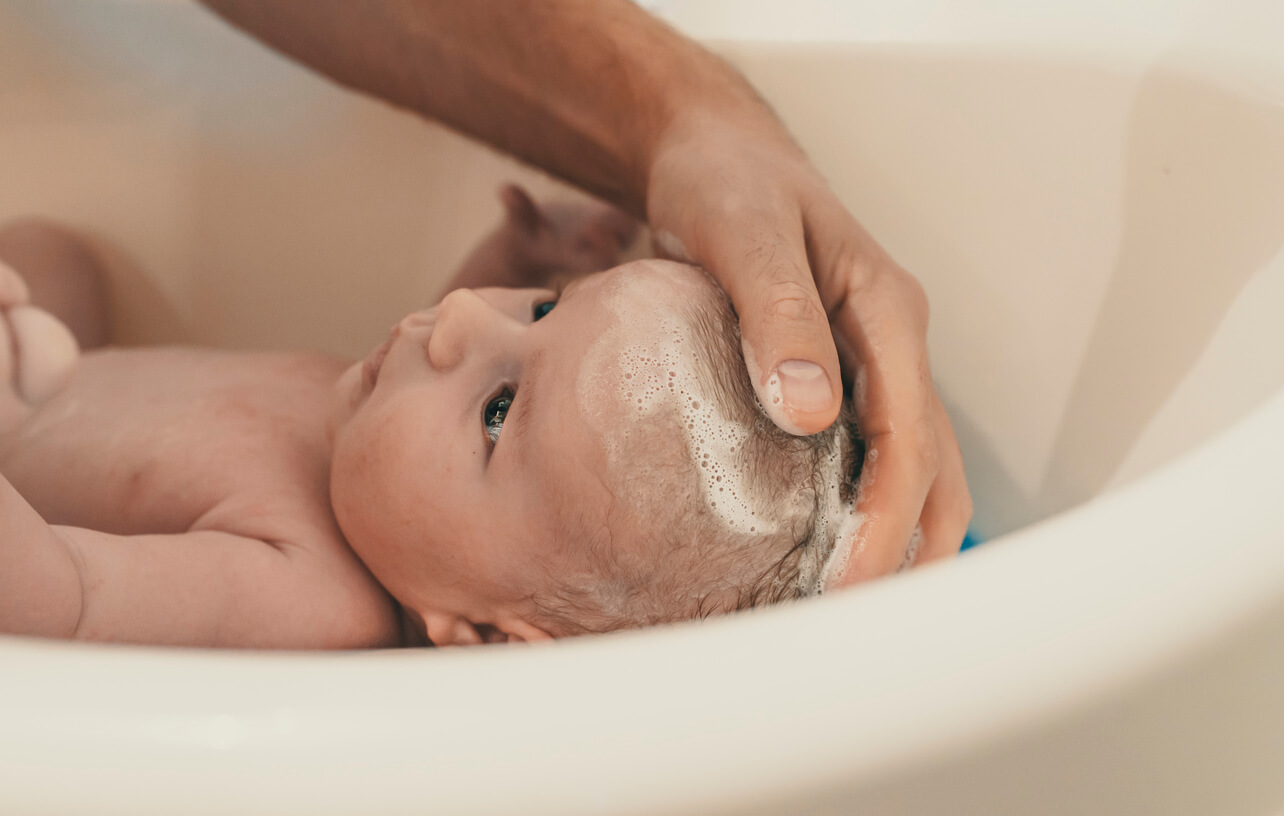7 Things You Didn't Know About Babies' Skin


Written and verified by the dermatologist Maria del Carmen Hernandez
Babies’ skin requires certain care compared to that of adults. This is due to the different characteristics it possesses because it’s not fully developed. For this reason, here are some things you didn’t know about babies’ skin.
1. At first, it’s not pretty
At birth, the skin is covered with a serous substance that acts as a protection and natural moisturizer. It’s also loaded with lipids, proteins, and amino acids, along with antimicrobial and antibacterial compounds. The skin surface, in the initial months, may appear somewhat rough, pale, and with different shades that become uniform over time.
2. It’s prone to rashes
The lack of complete maturation of the baby’s skin gives it a higher pH than that of adults. Therefore, experts recommend the use of skin care products that are similar to the skin’s natural pH level. In fact, it should be kept free of irritants such as nasal secretions, urine, saliva, feces, and dirt.
Continued exposure to these factors can lead to discomfort, rash, irritation, infection, and breakdown of the skin barrier. In addition, about 40% to 50% of infants develop milia on the face, which is characterized as benign and transient keratin dermal cysts.
You may be interested in: The Causes of Flaky Skin in Babies

3. It’s as thin as paper
Newborn babies’ skin is characterized by being sensitive, delicate, and thin. At the same time, the layers that compose it aren’t fully developed. Therefore, its thinness can produce a greater probability of bacterial growth and a greater predisposition to irritation and dermatitis.
4. Their skin is covered with hair
Before birth, the surface of babies’ skin is covered with a white serous substance called vernix. These little ones even have lanugo on their bodies, which is a layer of very fine hair on the back, arms, legs, face, and ears. This has the function of insulating the skin from the lack of body fat. However, it’s not always present after birth, as it’s sometimes shed earlier and is part of the composition of meconium.
5. You don’t need to bathe them frequently
Babies’ skin has more water than that of adults. For this reason, they need less time for baths and rinses than adults. Therefore, about 3 baths per week are recommended during the first year of life. In fact, this amount should be enough to avoid over-drying the skin surface.
If babies’ skin is too dry, it’s best to apply hypoallergenic, fragrance-free, and alcohol-free moisturizing cream and spread it with light massages and caresses.
Read also: Keys to Keeping Your Baby’s Skin Moisturized
6. Babies’ skin burns easily
Newborn skin takes a long time to develop its natural acid mantle that protects it from dryness and acts as a defense mechanism against viruses and bacteria. In addition, their thin skin puts them at greater risk for sunburn. For this reason, the American Academy of Pediatrics recommends not exposing children under 6 months of age to direct sunlight.
At the same time, physical sunscreens are preferred over chemical ones, due to their low absorption power and their great capacity to remain on the surface of the skin.

7. Caressing enhances the secretion of oxytocin
As mentioned above, the baby’s skin is very sensitive, even to physical contact. Therefore, any type of contact, such as massages, kisses or caresses, stimulates the release of oxytocin. This substance is associated with pleasurable sensations between people. Consequently, the bond between the child and adults is through their skin, a nexus that provokes emotions in both parties.
Baby’s skin needs special care
Baby’s skin is more sensitive and requires specific care regarding hygiene, moisturizing, and protection. In addition, its natural protective barrier isn’t fully developed, so extreme protective measures must be taken.
Therefore, direct exposure to ultraviolet rays isn’t recommended before 6 months of age. Also, the correct choice of sunscreen and its proper use are other tips to take into account.
Babies’ skin requires certain care compared to that of adults. This is due to the different characteristics it possesses because it’s not fully developed. For this reason, here are some things you didn’t know about babies’ skin.
1. At first, it’s not pretty
At birth, the skin is covered with a serous substance that acts as a protection and natural moisturizer. It’s also loaded with lipids, proteins, and amino acids, along with antimicrobial and antibacterial compounds. The skin surface, in the initial months, may appear somewhat rough, pale, and with different shades that become uniform over time.
2. It’s prone to rashes
The lack of complete maturation of the baby’s skin gives it a higher pH than that of adults. Therefore, experts recommend the use of skin care products that are similar to the skin’s natural pH level. In fact, it should be kept free of irritants such as nasal secretions, urine, saliva, feces, and dirt.
Continued exposure to these factors can lead to discomfort, rash, irritation, infection, and breakdown of the skin barrier. In addition, about 40% to 50% of infants develop milia on the face, which is characterized as benign and transient keratin dermal cysts.
You may be interested in: The Causes of Flaky Skin in Babies

3. It’s as thin as paper
Newborn babies’ skin is characterized by being sensitive, delicate, and thin. At the same time, the layers that compose it aren’t fully developed. Therefore, its thinness can produce a greater probability of bacterial growth and a greater predisposition to irritation and dermatitis.
4. Their skin is covered with hair
Before birth, the surface of babies’ skin is covered with a white serous substance called vernix. These little ones even have lanugo on their bodies, which is a layer of very fine hair on the back, arms, legs, face, and ears. This has the function of insulating the skin from the lack of body fat. However, it’s not always present after birth, as it’s sometimes shed earlier and is part of the composition of meconium.
5. You don’t need to bathe them frequently
Babies’ skin has more water than that of adults. For this reason, they need less time for baths and rinses than adults. Therefore, about 3 baths per week are recommended during the first year of life. In fact, this amount should be enough to avoid over-drying the skin surface.
If babies’ skin is too dry, it’s best to apply hypoallergenic, fragrance-free, and alcohol-free moisturizing cream and spread it with light massages and caresses.
Read also: Keys to Keeping Your Baby’s Skin Moisturized
6. Babies’ skin burns easily
Newborn skin takes a long time to develop its natural acid mantle that protects it from dryness and acts as a defense mechanism against viruses and bacteria. In addition, their thin skin puts them at greater risk for sunburn. For this reason, the American Academy of Pediatrics recommends not exposing children under 6 months of age to direct sunlight.
At the same time, physical sunscreens are preferred over chemical ones, due to their low absorption power and their great capacity to remain on the surface of the skin.

7. Caressing enhances the secretion of oxytocin
As mentioned above, the baby’s skin is very sensitive, even to physical contact. Therefore, any type of contact, such as massages, kisses or caresses, stimulates the release of oxytocin. This substance is associated with pleasurable sensations between people. Consequently, the bond between the child and adults is through their skin, a nexus that provokes emotions in both parties.
Baby’s skin needs special care
Baby’s skin is more sensitive and requires specific care regarding hygiene, moisturizing, and protection. In addition, its natural protective barrier isn’t fully developed, so extreme protective measures must be taken.
Therefore, direct exposure to ultraviolet rays isn’t recommended before 6 months of age. Also, the correct choice of sunscreen and its proper use are other tips to take into account.
All cited sources were thoroughly reviewed by our team to ensure their quality, reliability, currency, and validity. The bibliography of this article was considered reliable and of academic or scientific accuracy.
- Gallardo Avila PP, Méndez MD. Milia. [Actualizado el 10 de abril de 2021]. En: StatPearls [Internet]. Treasure Island (FL): StatPearls Publishing; 2021 enero-. Disponible en: https://www.ncbi.nlm.nih.gov/books/NBK560481/
- Prasad HR, Srivastava P, Verma KK. Diaper dermatitis–an overview. Indian J Pediatr. 2003 Aug;70(8):635-7. doi: 10.1007/BF02724253. PMID: 14510084.
- Blume-Peytavi U, Hauser M, Stamatas GN, Pathirana D, Garcia Bartels N. Skin care practices for newborns and infants: review of the clinical evidence for best practices. Pediatr Dermatol. 2012 Jan-Feb;29(1):1-14. doi: 10.1111/j.1525-1470.2011.01594.x. Epub 2011 Oct 20. PMID: 22011065.
This text is provided for informational purposes only and does not replace consultation with a professional. If in doubt, consult your specialist.








